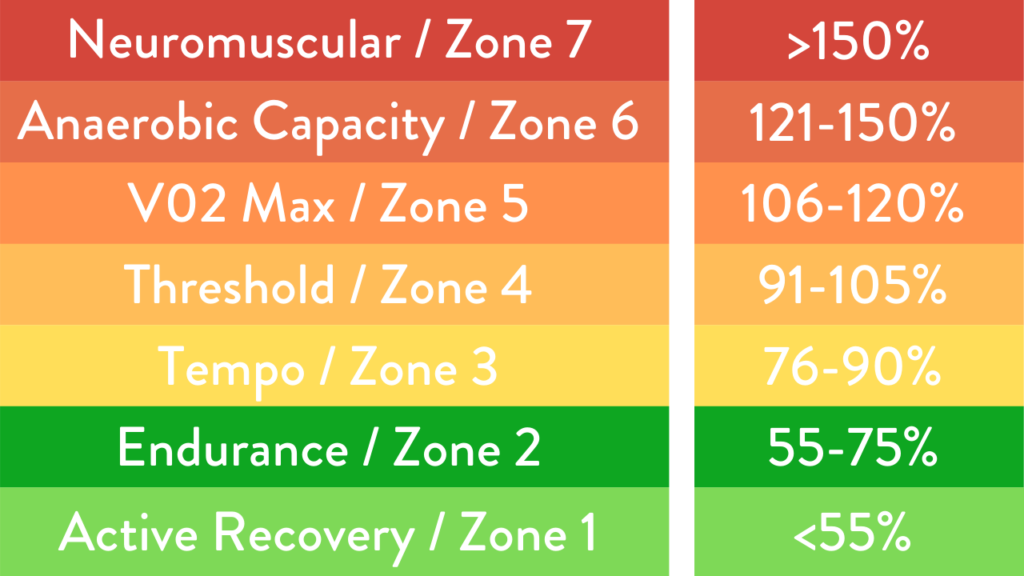A critical training factor for getting faster on the bike is building your Functional Threshold Power (FTP), whereby improving your FTP will separate you from your competition, delay the onset of fatigue and simply make you a stronger and better cyclist. So, in this article, I will outline the concept of aerobic threshold training, and in addition, I will also provide various methods of threshold testing. Once I have outlined the qualities of aerobic threshold, I will provide a practical guide on how to train your aerobic threshold power and improve your FTP to make you a better cyclist.
No doubt, the chances that you have heard about FTP before are high. However, in the slight chance you have not come across the term FTP, well, this article will explain what FTP is, and how to become a faster, stronger, and better cyclist using FTP.
Before we begin, let’s put this into perspective:
Are you a cyclist training ‘hard’ everyday, but cannot yield results or get faster?
Well, recall back to the article on rest and recovery, and how training too hard, and too often, only results in accumulative fatigue, that inevitably leads to staleness and performance plateaus.
“The fact is the vast majority of recreational and amateur road cyclists hit a plateau. It could be anywhere between one to two years into their cycling journey. While anecdotal – from our experiences working with hundreds of recreational and amateur cyclists from all over the world – riding too hard, too often, is mostly the root cause of this ‘plateau’.
Logically, this makes sense too. You’re trying to make the most of your limited time to train, so you ride hard most of the time. But unfortunately, this strategy crescendos into a fatigued state, leaving you unable to really progress your cycling”.
Road Cycling Academy (RCA)
Our mission at the Road Cycling Academy is to build stronger cyclists, no matter their training experience or fitness levels. But often amateur cyclists train to cycle at a speed that ‘looks’ good on Strava for their followers.
And then, on the other side of the spectrum, cyclists are constantly trying to increase their power output above a magic number of 300, for some reason.
However, both cyclists finish their training session, ‘jelly legged’, but are not getting faster on their benchmark climb or TT course.
Why?
Well, it simply boils down to training the physiological system in the wrong manner.
To get faster, and more efficient on the bike, training your threshold or FTP is a key more powerful cycling.

What Is Cycling FTP?
Threshold or lactate threshold refers to the exercise intensity, at which the accumulation of lactate is larger than its removal, resulting in diminished muscle force production [1]. Simply speaking, FTP or lactate threshold refers to the ‘maximal sustainable power’ cyclists can withstand for an extended period, commonly one hour.
Lactate accumulation is known as the fatiguing factor in all athletes, cyclists included, where the human body shifts away from supplying energy aerobically, to supply the energy demands through anaerobic pathways, known as the anaerobic glycolysis system – anaerobic glycolysis – only occurs when the cycling demands are beyond the capacity of the cyclist to sustain a given intensity aerobically [1]. However, it is important to understand that lactate is the by-product of excess pyruvate acid, which in turn transforms into lactate. Now, when the body produces too much lactate, as a biomarker, hydrogen ions are released from the lactate, which ultimately results in a loss in muscle production, commonly termed as ‘muscle fatigue’ [1]. When this occurs, the muscles can no longer produce force, and simply ‘switch off’. Think that ‘jelly legged’ feeling.
Here’s the thing…
The only way to mitigate ‘excess’ accumulation of lactate, is to train your physiological systems to become more efficient at tolerating lactate. And it’s very simple, that is – train your body yo tolerate excess lactate. We’ll get into this down the page.
But first, why is this important?
Because the greater your lactate threshold is, the greater your endurance [1].
What many cyclists don’t realise is the fact that high lactate thresholds are the determining factor to improved endurance as a cyclist, and not VO2max – maximal oxygen uptake,[1] contrary to common understanding.
To better understand the above mechanisms, essentially during an incremental ‘cycling tests’ [1] such as the common Ramp Test on Zwift, lactate accumulates in a linear fashion, until a point of a sudden rise in lactate occurs, referred to ‘lactate inflection point 2’ or ‘LT2’ [1]. At this point, the body can no longer produce energy aerobically, and as a biomarker, lactate production along with various other mechanisms, lead to that ‘jelly’ feeling cyclists often feel after executing a breakaway attempt, and eventually blowing up, due to fatigue.
Well, such fatigue comes down to many factors, but VO2max, which is physiologically difficult to alter since it is indeed the ‘maximum’ one can breathe and utilise oxygen, simply does not determine a performance outcome [1]. However, lactate accumulation – is in fact, the most important performance determinant that can be trained significantly [1] and determine a positive race outcome.
Consequently, a greater FTP for you as a cyclist will mean greater endurance. Who doesn’t want that?
4 Ways to Test Your FTP
With a basic understanding on lactate threshold or FTP, now let’s explore 4 different approaches on how to assess your FTP. While each FTP assessment method is different, they all provide a moderately to an accurate FTP value, when performed correctly and with precision by cyclists.
Importantly, for the most accurate results, you must use a power meter of the sort, and then you’re all set. However, don’t stress, because an estimate of your lactate training zone falls at about 85% maximum heart rate (MHR) [2]. So, all you need to do is to calculate your MHR, and this can be found from your MHR recorded in a sprint finish of a race. Or, using the equation of 208-0.7 x Age, will provide a mostly accurate evaluation MHR [3] for a vast majority of the population.
Conducting the FTP test can be done either indoors on a trainer, or outdoors on a quiet, uninterrupted road. Commonly, many cyclists, including professional cyclists, opt to test their FTP on a hill with a slight gradient, to add an element of intensity, for a more even power output.

60 Minute FTP Test
As the name suggests, the 60-minute FTP test requires a maximal sustained power output, lasting over the 60-minute duration [4]. Performing the 60-minute FTP test must be done on a flat course, and be treated as a 60 minute ‘TT’ [4].
Advantage
The 60-minute FTP protocol yields the most accurate results for cyclists, as essentially, FTP is the value that correlates to power output sustained for 60 minutes.
Disadvantage
While the 60-minute FTP test is considered ‘gold standard’ in terms of accuracy, it is psychologically and physically demanding, and probably won’t provide an accurate measure for most cyclists who can’t sustain (or pace) such power for an extended period.
20 Minute FTP Test
A derivative of the 60-minute FTP test, the 20-minute FTP protocol requires a maximal sustained power output that can be generated for a duration of 20 minutes [4]. However, upon cessation of the 20-minute FTP test, the mean power output is then represented at 95% of the power sustained for the 20-minute duration, to provide an equivalent ’60-minute FTP’ value [4].
Advantage
Most suitable for trained amateur cyclists, as it is less daunting than the 60-minute FTP test, both psychologically and physically [4]. In addition, the 20-minute FTP test is relatively short, reliable, and easily replicated on an indoor trainer on a regular basis [4].
Disadvantage
While the 20-minute FTP test is ‘relatively’ easier than the traditional 60-minute FTP test, it is a tough, and mentally demanding test for the less trained cyclist, as it requires an extensive amount of focus and even pacing.
The Ramp Test
The Ramp Test is an old concept, but recently popularised within the indoor cycling world, where it involves incremental testing, until absolute fatigue is achieved. Once the Ramp Test is over, a calculation is made using 75% of the best 1-minute power to estimate FTP.
Advantage
The ramp tests is relatively less demanding than both the 60- and 20-minute FTP testing, as it does not require a ‘threshold’ sustained effort. With that in mind, the Ramp Test is an easily replicated protocol for cyclists to repeat throughout the season to measure performance adaptations.
Disadvantage
While it may be tempting to perform an ‘easier’ version of the traditional type FTP testing, the Ramp Test can often yield inaccurate power values for many cyclists, when comparing true results from the 60- or 20-minute FTP tests [5]. A common train of thought by sport scientist, follows the notion that Ramp Testing favours the larger, more powerful, anaerobically gifted cyclists with fast twitched Type 2B muscle fibres, which are great at producing large amounts of force, but for a short duration, and not sustained efforts [6].

The Half Monty FTP Test
At the Road Cycling Academy (RCA), we prescribe a new protocol for FTP testing that is highly researched by the Wahoo Sport Science Team, and easily performed by cyclists of all levels, whilst providing accurate results [7].
So, what is the Half Monty?
The Half Monty uses a combination of the Ramp Test and the 20-minute FTP test to provide an accurate measure of FTP, Maximal Aerobic Power (MAP) and Lactate Threshold Heart Rate (LTHR) [7].
The main attributes of the Half Monty are a ramp component, then followed by a 20-minute easier, submaximal test, that in combination with various metrics such as age and gender, provide a more accurate FTP than the common Ramp Test. This is done through Wahoo’s algorithm that combine and analyse results of the Ramp Test and 20-minute submaximal test [7].
Why do the Half Monty?
Because, it’s practical for most cyclists.
How to Train Your FTP
Training to improve your lactate tolerance and FTP follows one simple physiological training concept, and that is to use interval training [8]. However, it is important to first build a strong aerobic base fitness to achieve maximum results.
Quite simply, when an intense session above threshold power or heart rate zones are split into intervals, followed by a short recovery period, performance for each split can be maintained both physically and psychologically [8]. Since each interval is performed beyond threshold, mechanical and metabolic adaptations can take place such as improved exercise tolerance, and most notably improved mitochondria, and oxygen utilisation to the muscles [8].
With the correct training principles and programming, intervals should follow the model of progressive overload. Thus, over a duration of a few weeks, the above threshold intensity of your interval training – to which result in physiological adaptations – can eventuate into a continuous sustained threshold effort, where essentially each interval is ‘combined’ into a continuous effort [8].
Ultimately, improved endurance, lactate threshold and FTP!
Some examples…
5×5 Minute FTP Intervals
This method falls into the category of long interval training. The session comprises of 5×5 efforts session which involves 5 minutes of cycling 105% FTP, followed by a brief active recovery or soft pedalling period (notably zone one), repeated 5 times. During the active recovery period, the goal is keep the ratio of work to rest ratio the same. For example, every 5 minute effort, is followed by a 5 minute active recovery. However, for the more advanced cyclist, a less rest can be programmed.
Importantly, for the beginner cyclist it is important to progressively build up to the 5×5 efforts, to produce achievable results. For example, 2×5 minute efforts can be programmed on a fortnightly schedule, and increased to 5×5 minute over a period of 8 weeks.
The 5×5 method is extremely popular among the criterium racers, as it is extremely sport specific to the demands of the race, which often involve efforts lasting around 5 minutes in duration.
2×20 Minute FTP Intervals
Now, the 2×20 minute FTP intervals are also considered long intervals, and are harder than the former, but with the sole aim to stress the tolerance of lactate, and build aerobic endurance capacity, when each interval is performed at approximately 90% your FTP value.
Once the first set of 20 minute effort is complete, it is followed by a longer recovery, of which may be either an active recovery or simply resting for 10 minutes. Remember, it is important to recover to allow a quality second set.
The 2×20 minute method can be extremely specific to training FTP for climbers, for the very reason that it targets both climbing and FTP training.
Low Cadence, Strength Intervals
With this method, the focus lies on stressing the aerobic system through pedalling at a low cadence. The goal is to perform the 5×5 or 2×20 minute intervals but at a cadence of 60-70 rpm, to target the mechanical properties of the working leg muscles, under a threshold load.
When low cadence intervals are performed, the muscles are stressed mechanically, which in turn results in an extremely rapid accumulation of lactate over a sustained period. As a training result, low cadence drills can drastically improve lactate tolerance.
Again, its all about quality over quantity. Therefore, aim to build up your strength effort before diving into the toughest of all cycling workouts. For example, attempt a single 20 minute effort at a low cadence, followed by a 2×20 in the progressing weeks.
Conclusion
Now that you have an understanding on the concept of threshold training, it’s important to integrate ‘threshold’ sessions as a tool to improve your cycling. Through cycling at a threshold intensity, not only will you become a stronger cyclist from a physiological perspective, but a mentally tougher cyclist – a cyclist who can resist the burn of lactate, but knows and understands the benefits. Now, remember, the pain of training at threshold is only temporary, but when you combine every effort performed at threshold, metabolically, the human body adapts more effectively, whilst the training session remains achievable. So, the next time you head out for a long ride ride, set aside 20 minutes to work on your threshold, and then continue on as usual.
As the saying goes, “No Pain, No Gain”.

Remember, the pain is only temporary, but the positive results are a because you were resilient to that pain and didn’t give up!
References:
[1] A. K. Ghosh, “Anaerobic Threshold: Its Concept and Role in Endurance Sport,” Malays J Med Sci, vol. 11, no. 1, pp. 24–36, Jan. 2004.
[2] R. Tanner and C. Gore, Physiological tests for elite athletes. Champaign, IL: Human Kinetics, 2013.
[3] M. A. SARZYNSKI et al., “Measured Maximal Heart Rates Compared to Commonly Used Age-Based Prediction Equations in the Heritage Family Study,” Am J Hum Biol, vol. 25, no. 5, pp. 695–701, 2013, doi: 10.1002/ajhb.22431.
[4] A. Sørensen, T. K. Aune, V. Rangul, and T. Dalen, “The Validity of Functional Threshold Power and Maximal Oxygen Uptake for Cycling Performance in Moderately Trained Cyclists,” Sports (Basel), vol. 7, no. 10, p. 217, Oct. 2019, doi: 10.3390/sports7100217.
[5] M. I. Black, A. M. Jones, J. A. Kelly, S. J. Bailey, and A. Vanhatalo, “The constant work rate critical power protocol overestimates ramp incremental exercise performance,” Eur J Appl Physiol, vol. 116, no. 11, pp. 2415–2422, 2016, doi: 10.1007/s00421-016-3491-y.
[6] J. Talbot and L. Maves, “Skeletal muscle fiber type: using insights from muscle developmental biology to dissect targets for susceptibility and resistance to muscle disease,” Wiley Interdiscip Rev Dev Biol, vol. 5, no. 4, pp. 518–534, Jul. 2016, doi: 10.1002/wdev.230.
[7] “The Half Monty fitness assessment: Everything you need to know – Wahoo Fitness Support.” https://support.wahoofitness.com/hc/en-us/articles/4404067414418-The-Half-Monty-fitness-assessment-Everything-you-need-to-know (accessed Oct. 18, 2021).
[8] A. M. Jones and A. Vanhatalo, “The ‘Critical Power’ Concept: Applications to Sports Performance with a Focus on Intermittent High-Intensity Exercise,” Sports Med, vol. 47, no. Suppl 1, pp. 65–78, 2017, doi: 10.1007/s40279-017-0688-0.

